#daikaiju roars
Explore tagged Tumblr posts
Text



Gangle taking responsibility and not throwing the others under the bus for her own benefit is so indicative of her character
6K notes
·
View notes
Text
Cryodon (child/late teen) and Matergivre sound showcase
Had loads of fun making these fr, if you manage to identify every sound used for this then fucking bravo goddamn
#digital art#kaiju#daikaiju#giant monsters#monster#raekaiju#dragon#roars#original kaiju#kaiju au#kaiju monster#kaiju oc#kaiju art#sound design
12 notes
·
View notes
Text
we appreciate miniatures a lot on here but one of my favorite things abt the artistry of ultraman is the daikaiju themselves... the suits, the way they make them move and present them to make them feel big, the sound effects and roars.... some ultra kaiju are so much more memorable than a lot of other motw despite being just like animals and not talking or anything. i saw a post on twitter once abt how even if you have a really incredible design for a monster it doesnt matter if it is presented poorly--it's the presentation that makes or breaks it. and to me theres a real joy in seeing what tsupro does in that presentation.
8 notes
·
View notes
Text
Kaiju Week in Review (October 30-November 5, 2022)
This week actually brought more news than I was expecting... and I was expecting a lot!

Takashi Yamazaki will direct—or rather, has been directing—the next live-action Toho Godzilla film, which started shooting in March under the working title Blockbuster Monster Movie. (Gigant called it!) He also wrote the script and will supervise the visual effects, a level of control never before afforded a Godzilla director. Yamazaki previously directed the King of the Monsters in the cold open for Always: Sunset on Third Street 2 and the Godzilla the Ride: Giant Monsters Ultimate Battle attraction, but he's also been extremely prolific as a director of visually extravagant genre movies, including Returner, Space Battleship Yamato, the live-action Parasyte films, and Lupin III: The First.
Little is known about the story, save for the time period: early postwar Japan, specified in a casting call as 1945-47. That's rare territory for a Godzilla story. I believe Godzilla: Awakening is the only other example, and that was a globe-trotting adventure in which the Big G never set foot on Japanese soil. So it promises to be something truly fresh for his 69th anniversary. Nice.

The main attraction of Toho's Godzilla Fest livestream was the event's third tokusatsu short, Fest Godzilla 3: Gigan Attacks. These things get better every year; compared to Godzilla vs. Hedorah, Gigan Attacks had a bigger set, a new suit for the enemy monster and a much nicer-looking suit for Godzilla, sharper fight choreography, and more intricate VFX. If they keep getting longer too, maybe Toho will accidentally make another tokusatsu feature by the 2030s.
For the next few days, you can watch it on YouTube here (starts at 6:57:00 and is followed by a ton of behind-the-scenes footage). After the archived stream gets banished, find it on archive.org.

I kind of love when animation makes kaiju lighter and bouncier than they should be for the sake of slicker fight scenes, and the other Godzilla Fest short, Godzilla vs. Gigan Rex, certainly delivered on that front. And if you've always wanted Toho to revisit the Heisei continuity, there are a few hints that this Godzilla is Junior, including the long-overdue return of Megumi Odaka as the narrator. (As a Wikizilla bureaucrat, I am obligated to add that these are only hints, akin to the way IDW's Godzilla comics will sometimes allude to the films without officially being in continuity with them.) Assuming this is Junior, he certainly does his old man proud.

An onslaught of new Movie Monster Series figures were revealed this week: Godzilla '84, Gamera '96, two Shin Ultraman variants, Zarab's Ultraman disguise, and Mefilas. A site called Awesome Collector also opened preorders for Manda '04, Baragon '65, Ebirah '66, Hedorah '04, Godzilla '04, and King Ghidorah '91, due in February or March 2023. No images for them yet, but they foretold the MMS Salunga figure in the past. Finally, Showcase Daikaiju claims that the Godziban versions of Rodan and Anguirus will be shipping out next month. I'm more excited for those than the ones we got total confirmation of, to be honest. Though the Godzilla '84 looks more on-model than my NECA...
Oh yeah, there's an S.H.MonsterArts of the original Gigan on the way too. Not my thing, but nice to see them remember the Showa era exists.
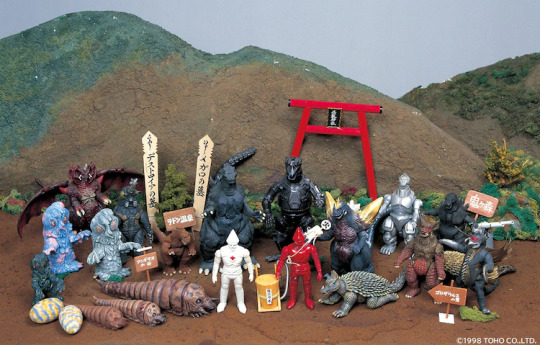
Buried in a Hollywood Reporter article about Blockbuster Monster Movie is the revelation that Godzilla Island will be coming to the English Godzilla YouTube channel (GODZILLA OFFICIAL by TOHO) later this month. Yes, the one from the late 90s where Bandai toys portray all the monsters. This will be its first official English translation; as someone who's watched the whole thing raw, I'm excited to finally learn what the hell's happening in some of those story arcs. The special effects are the least wild part of the show, truly.

Netflix released a full trailer for Troll which looks pretty spectacular; I did not realize the film had this much money to play with. Roar Uthaug (The Wave, the Tomb Raider remake) is the director. It's always nice to see another giant monster movie set in Europe—how many have there been since the glory days of Reptilicus, Konga, and Gorgo? Okay, maybe "Konga" and "glory days" don't belong anywhere near each other... the point stands.
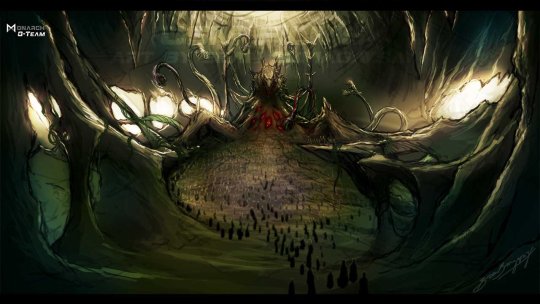
O'Shea Jackson Jr. has been writing the pilot script for a G-Team animated series with Toho Kingdom media relations director Chris Mirjahangir. (In case you forgot, that's Monarch's military branch, callously discarded in Godzilla vs. Kong like most of the world-building in King of the Monsters; Jackson played Barnes.) No story details yet, beyond plans to include Biollante and Gigan. Bear in mind this is far from a done deal; the strategy seems to be going public early to convince Toho and Legendary the demand is there.
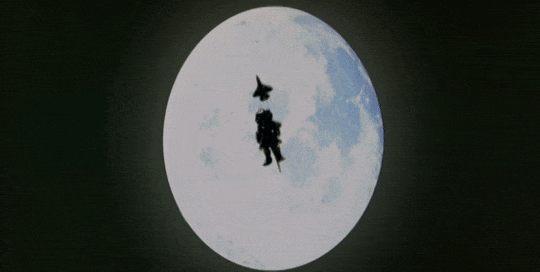
Fathom Events screenings of Godzilla Against Mechagodzilla grossed $335,000 from 727 theaters on Thursday, good for fifth place that day. Apart from the introduction by Chief Godzilla Officer Keiji Ota (who I hear was very wooden), Fathom included last year's Godzilla vs. Hedorah short and some behind-the-scenes footage of said short which I'm not sure has ever been released before. Thankfully, a couple people recorded that part.
The film itself had some frame rate issues, at least at certain theaters. The video quality also apparently dropped off whenever there were any English supers. The subtitles used the (superior) script from the old TriStar DVD, though a handful of typos suggested they were retyped. Still, people seemed thrilled at getting to catch a Toho Godzilla movie in theaters, and I can't blame them (G-Fest has spoiled me rotten).
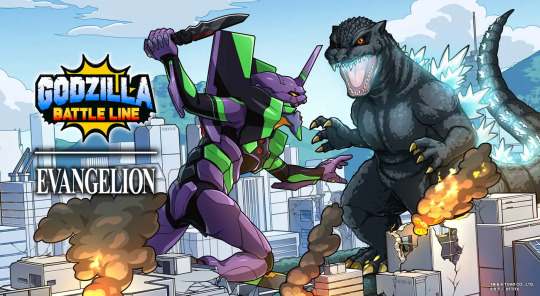
Evangelion Unit-01 has officially arrived in Godzilla Battle Line, with the Fourth Angel (called Sachiel in the original show) to follow mid-month. She's armed with a Gatling gun and a few neat abilities, like an AT field reducing the damage she takes while she's rushing and resistance to self-destructing units like Burning Godzilla and Zetton. Be forewarned that Shinji screams in agony whenever an Eva Leader loses a match. Battle Line also gave Kiryu an Evangelion skin—and the ability to evolve into the Modified version from Tokyo S.O.S. after being defeated twice in a match. Also, GigaBash released a teaser for their upcoming Godzilla DLC, and announced that three more Toho monsters would join the game as well. Be sure to feign surprise when they turn out to be King Ghidorah, Mechagodzilla, and Mothra.

I'll close with yet another plug for another kaiju obscurity brought to light by @spacehunter-m. This one's the 1958 German version of Godzilla Raids Again with English subtitles. It's a more straightforward dub than Gigantis; no banana oil, fire monsters, or unrelenting narration in this one. It also looks better than the HD transfer Toho has been trotting out for years, despite being in SD!
#kaiju week in review#godzilla#gigan#shin ultraman#gamera#ultraman#neon genesis evangelion#godzilla battle line#gigabash#godzilla vs. gigan rex#gigan rex#godzilla against mechagodzilla#kiryu#mechagodzilla#biollante#g team#troll#godzilla island#godzilla raids again#kaiju#tokusatsu#blockbuster monster movie#shin ultraman spoilers#video games
130 notes
·
View notes
Text
Kaijuly 2021
1. Favorite Pacific Rim series kaiju\ Otachi 2. Favorite kaiju roar\ Godzilla 1984 3. Least liked Godzilla film\ Godzilla (1998) 4. Favorite Gamera film\ Gamera Super Monster 5. Favorite zord\mecha from “Power Rangers”\ Daizyuzin (”original” Megazord) 6. Favorite Gridman\Dynazenon kaiju\ Hmm, can’t seem to find the one I’m looking for online to name it 7. Favorite Legendary redesign of a Toho kaiju\ Rodan 8. Favorite Godzilla battle\ Godzilla’s 2nd battle with Mechagodzilla in the original Godzilla VS Mechagodzilla 9. Ugliest kaiju (or seijin)\ Godzilla ‘67 10. Favorite Showa era Gamera kaiju\ Jiger 11. Favorite movie case\cover art from a kaiju film\ New World’s Godzilla VS Gigan VHS cover 12. Crossover film you want to see made\ Godzilla VS Gamera 13. Favorite Gamera suit\ Gamera 1995 14. First kaiju film\ Godzilla VS Gigan 15. Favorite Ultraman series\ Ultraman 16. Favorite Toho kaiju that isn’t Godzilla\ Varan 17. Favorite kaiju battle that doesn’t involve Godzilla\ King Kong VS Mechanikong from King Kong Escapes 18. Favorite kaiju beam\attack\weapon\ Mechagodzilla 1974′s beam medley 19. Favorite Ultra kaiju\seijin\ Gigasaurus 20. Favorite Godzilla toy you own\ The memorial box Godzilla 1984 figure 21. Favorite kaiju arrival in a daikaiju film\ Godzilla’s full reveal in The Return of Godzilla 22. Favorite song from a kaiju film\ Myth by Bakufu Slump from Gamera: Guardian of the Universe 23. Worst kaiju film you’ve ever seen\ Deep Sea Monster Reigo 24. Favorite mecha unit from all media\ Mechagodzilla 1974 25. Favorite kaiju cameo\ Godzilla on the Simpsons go to Japan episode 26. Favorite non-Japanese kaiju\ King Kong 1976 27. Favorite Ultraman series opening song\ Ultraman Great 28. A kaiju toy you really want\ Bandai’s 8 inch Baragon 29. Favorite kaiju video game\ Godzilla: Monster of Monsters 30. Favorite non-Ultraman giant hero\ Jet Jaguar 31. Godzilla Ultima design opinion\ It’s the one design I’m really indifferent with
#kaijuly#kaiju#monsters#tokusatsu#godzilla#gamera#ultraman#sentai#super sentai#pacific rim#gridman#meme
3 notes
·
View notes
Text
music that is just so awesome: brown bird, blockhead, a tribe called red, jack conte, gregory and the hawke, the caretaker, the arkhams, the avalanches, jeff rosenstock, amigo the devil, the correspondents, MIKA, brockhampton, virtual bird, the orion experience, modest mouse, hot dad, low roar, that handsome devil, the mountain goats, jonathan coulton, ajj, jack stauber, the buttress, reel big fish, they might be giants, jason webley, dogbite, a perfect circle, death has 1000 ears, 1 trait danger, the airborne toxic event, jukebox the ghost, gogol bordello, the microphones, chukwudi hodge, hop along, larkin grimm, blue october, ariel pink, IAMX, silt, squirrel nut zippers, tom lehrer, robin aigner, fidlar, lincoln, cake, mashrou’ leila, MGMT, fun., doja cat, glass animals, iron & wine, ludo, mother mother, kimya dawson, jeffrey lewis, kadhja bonet, tally hall, the dodos, joe hawley, hawaii pt II, mitski, the yellow dress, neutral milk hotel, say anything, punch brothers, puscifer, childish gambino, HMLTD, fiona apple regina spektor, death cab for cutie, st. vincent, the killers, andrew bird, eartha kitt, wicked shallows, car seat headrest, bear ghost, the cat empire, japanese breakfast, first aid kit, eivor, mount eerie, mindless self indulgence, days n daze, louie zong, WHY?, vampire weekend, miniature tigers, michael abels, ryan roth, daikaiju, the taxpayers, portugal. the man, bo en, the protomen, whiskey shivers, rilo kiley, bomb the music industry, the thermals, SOPHIE, i don’t know how but they found me, cosmo sheldrake, death grips, shovels & rope, fleet foxes, adia victoria, santigold, roy orbison, ryn weaver, the romanovs, PUP, walter mitty, streetlight manifesto, bitter ruin, mister heavenly
honorable mentions to tiny meat gang, mr. b, jeff williams, mc frontalot, jak tripper, professor elemental, and the aquabats because i can only say they’re awesome if i make it look like i’m just clowning around
85 notes
·
View notes
Text
Pondering GODZILLA: KING OF THE MONSTERS (2019)

Director Michael Dougherty amply demonstrates his credentials as a Godzilla fan in bringing to the screen a film that lovingly references myriad aspects of the various Toho series since 1954. This lavish and detailed homage to the legacy of Godzilla is full of nods that aficionados will find delicious and our favorite daikaiju have never looked more conscious and gloriously alive. It is crafted in an American summer blockbuster style in its breathless pacing so that one has to be quite sharp to spot all the goodies he’s woven into this third episode of Legendary’s MONSTERVERSE. While Gareth Edwards’ 2014 GODZILLA employed a Spielbergian touch, Dougherty offers the most Toho-esque installment so far in this franchise.
Essence of Toho
In my review of the 2014 Edwards film, I had speculated that a MONARCH-centered approach would be best going forward, and indeed that has been the case with both KONG: SKULL ISLAND and this film. Dougherty has taken that Toho Showa series’ leap into “super science,” with defensive masers, secret bases around the globe enveloping recumbent daikaiju, and the ORCA device, meant to communicate with the Titans. This approach, sort of sci-fantasy, enlarges the sandbox in which he can play and recalls what has been part of so many prior Godzilla outings. MONARCH’s Argo, an immense flying wing, seems to echo the various “Super X” vehicles from the Heisei series, the Marvel Comics S.H.I.E.L.D. helicarrier Behemoth from their Godzilla: King of the Monsters series, as well as being a nod to both the flying wing from George Pal’s THE WAR OF THE WORLDS (the Northrop YB-49) and to the name of the ship from JASON AND THE ARGONAUTS, so well depicted by Ray Harryhausen. One particular delight for me was the Osprey’s arrival at the Castle Bravo facility, recalling the opening of DESTROY ALL MONSTERS, where a helicopter descended into a similar circular vertical tunnel to reach the hidden base on Monster Island. And, as Toho had done with its production design, these MONARCH scientific/military installations are full of gigantic screens surrounded by flashing lights from which “officially concerned” humans can monitor the global monster action at a safe distance.
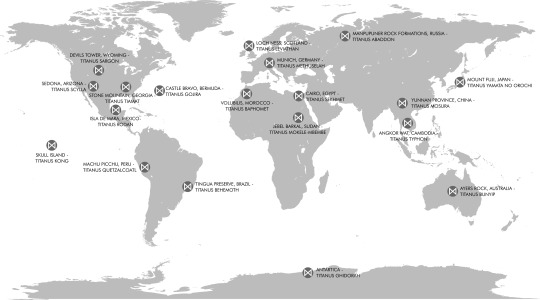
Eggleton’s Impact
I was impressed by the painterly cinematography in this most Eggletonian-looking of Godzilla films—I actually expected to see Bob acknowledged in the credits as his visual style so permeates many scenes. Fans of his paintings cannot miss how much of the imagery is flavored by this extraordinary artist’s numerous works. That impressionistic sensibility Edwards had captured in the HALO descent to San Francisco scene infuses much of this movie. And his method for viewing the Titans from human perspectives to make their scale apparent was also deliberately maintained by Dougherty. Despite so much care having been lavished on the sweeping imagery, these sumptuous frames fly by in fractions of a second, which has sadly become the standard action film approach to editing and pacing. That for me is a disservice to those who clearly worked diligently to craft impressive and iconic visuals—such splendor should not be snatched away so swiftly from our hungry eyes. Lingering just a bit longer on some of these fantastic moments would have been so much more satisfying. When King Ghidorah seizes Rodan’s volcanic aerie and regenerates his missing head in a very bizarre, placental manner, his dominance over a foreground cross suggests his demonic power, much as FANTASIA’s Chernabog perched atop Mount Triglav—a gorgeous and potent symbol. He then sends out a call to rouse the world’s Titans to do his bidding as their “usurper king.” That pivotal moment passes far too quickly. Would that the two flanking heads have paused and then looked to the central dominant head, who would return their gazes, then look skyward and begin voicing “the call.” Then the other two would join-in, very deliberately, with some unearthly new sound reaching out to be that irresistible global conscription summons. That could have kicked the scene up significantly. The triple voiced sound used in the film was less of a command, rather a sort of keening, which quietly lingered in the following scenes of the other Titans awakening. For my tastes it should have had more of a dramatic emphasis—and have been audibly unique to the moment. Even somehow having King Ghidorah take note of his new troops as they each arise and perhaps respond audibly to his summons would have made his dominance much clearer and more exciting—perhaps cutting back to him as his heads express a knowledge of each new disciple’s activation?
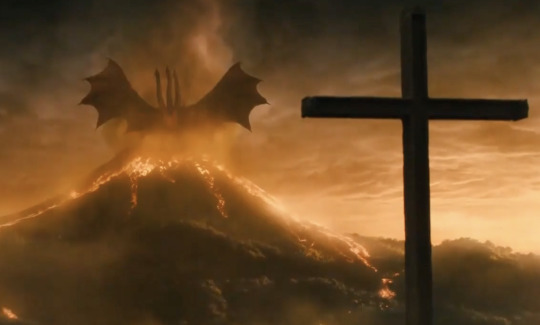
Daikaiju Design
The designs of the quartet of classic Toho stars move to the top of my favorites, as each are detailed, expressive, and dynamic. Tweaking Godzilla’s look to enlarge his dorsal plates and having them flicker even when not powering up for a blast of nuclear plasma works well—he crackles with latent energy. While the 2014 look is an excellent, naturalistic one, changing the primary row of dorsal plates to repeat the 1954 design and then bumping up the secondary rows to Heisei-styled size makes him more in line with earlier Gozilla incarnations. I’d still like him to sport a proper tertiary row of plates that are clearly defined, which has been a common aspect of many incarnations of the King of the Monsters. Taking those sauropod-esque feet and enlarging the claws for more of a predatory aspect looks fearsome, and I like the shortening of the whip tail of the 2014 version to be more like the standard Godzilla profile. And having a new climactic revival of “Burning Godzilla” was a fine choice, reigniting that concept from GODZILLA VS. DESTOROYAH. King Ghidorah is masterfully realized, a proud successor to DRAGONSLAYER’s Vermithrax Pejorative, who can fly, stride or wing-walk with sinuous beauty. That aspects of his wings echo a William Blake image of the Red Dragon really makes for such resonance. The three heads being somewhat independent with unique personalities was also a superb concept. Ghidorah’s condescending curiosity regarding those nasty, puny humans he was seeing for the first time—even to licking their corpses to explore them—brought forth his diabolically sinister consciousness. His gravity beams and the neck-glow charge-up are splendid. Mothra in her bioluminescent glory is stunningly conceived, from impressively carapaced larva to majestic moth-mantis-wasp imago—magnificent, mysterious, and with a feminine puissance. Rodan as the fantasy firebird, a magma-veined pterosaur, fiendishly skeksis-esque in angry avian awareness, has such presence. Bowing like a courtier to both the usurper and finally to the true king, he exhibits a calculating, conscious persona. His thrilling barrel-roll to take out the pursuing jets was about the most spectacular image we’ve seen of him, ever.
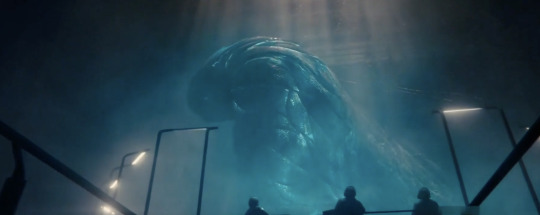
As Toho had done in SHIN GOJIRA, Godzilla’s roars from the various series were employed, as well as his roars from the 2014 film. I was hoping for more of the very deep vocalizations from the 1954 original. Mothra sounded as she always has, with plaintive chirrups and screes. The cries for both Rodan and King Ghidorah were not the originals, and were for me a bit more “generic giant monster” voices. I would have loved to hear new recreations of those readily recognizable Rodan yawps and cackles, and much more forward versions of KG’s triple toned “bidi-bidi-bidi” voice—rather than the faint references buried in the raucous sound design. I rather expected more original Toho monster sounds than were used for both of them, since Daugherty was employing past iconic sounds for both Godzilla and Mothra and seemed to be teasing that during the film’s production.
A Grim Setting
While there is some humor—not all of it apt— intended to break tension, the plot of this film builds upon the global revelation to the people of Earth that past super species were essentially their “gods,” knocking present day humans down a few notches on the dominance pyramid. The context is alarm and terror, though the MONSTERVERSE also offers awe and wonder as viewed through some of those studying the returning Titans. Serizawa remarks in a senate hearing that humanity should be viewed as Godzilla’s “pets”—and he means it. He respects “all forms of life” and sees our world as one that must have a balance which is inclusive of its natural organisms, regardless of where we might end up in Nature’s organic tapestry. Over the course of the film, much is learned about the fascinating past history of human societies who lived in harmony with the Titans. Toho implied some of this in their films—Mothra was regularly portrayed as an eternal goddess for the islanders she protected—but here it is made quite explicit and detailed. Godzilla’s temple lair in submerged Atlantis, with gigantic friezes and sculptures honoring him, is surely an enrichment of this ongoing saga. There is a dark side to this scenario wherein some see humans as being abusive to their world and thus in need of being forcibly “tamed,” and then there is the collective might of the military who want to subjugate these creatures and restore man’s preeminence—behavior that began in the original GOJIRA and sustained throughout most of the films.
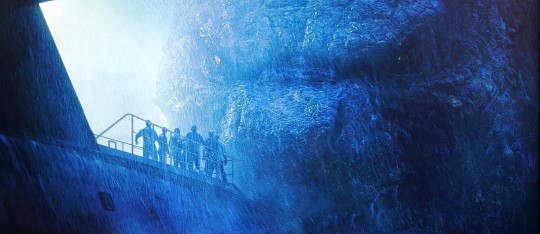
Dr. Emma Russell is an oddly polarized primary character. To begin, she seems a concerned mother who has rescued her daughter Madison from her husband’s descent into alcoholism, which had been incited by the death of their son Andrew during Godzilla’s San Francisco battle with the Muto’s. An aside: That plot aspect is reminiscent of a similar character motivation in the third of Kaneko’s Gamera trilogy, wherein a young girl’s commitment to invoking the destructive daikaiju Iris is sealed by her parents’ collateral death during a monster rampage in the first film where Gamera, an Earth defender, destroys his adversary Gyaos. That Emma is no “mother of the year” is quickly exposed when Allan Jonah’s eco-terrorists arrive to snatch she and her daughter (and her Titan controlling ORCA device) after they execute the innocent MONARCH crew studying Titanus Mosura. Emma has indoctrinated her daughter to comply with her pursuit of shattering mankind’s toxic presence by releasing the Titans as “antibodies” to the virus that is human kind. And Emma is in cahoots with these extremists, her obsession being the first cause setting in motion the slaughter of her MONARCH colleagues in China, Antarctica, and Mexico as well as the other locations wherein the Titans are roused to destroy their containment facilities. And countless others then perish around the globe as the revived Titans rage. The script makes her somewhat sympathetic as a mother—she is shown to love and be concerned with her daughter and mournful of her son—but one could not give her a pass for the oceans of blood on her hands. Nor should she be forgiven for making Madison a victim of Stockholm syndrome. Madison, comprehending the grievous practices kindled by her mother’s theories, does awaken to reject Emma’s deeds and then she strives at great risk to use the ORCA to solve the global catastrophe wrought by both Emma and Jonah’s fanaticism. There is a cut scene in the video release of Madison training with the eco-terrorists which would have underlined her submission to her situation—I would have included that for the parallel with Patty Hearst it presents. Madison ultimately is heroic, and her father Mark renews himself by stepping-up to guide MONARCH’s efforts to understand and control the Titans. He provides some crucial insights based on his knowledge of animal hierarchy and behavior. Ultimately, Emma seeks atonement through her sacrifice, which brings some justice to her character’s story, while Mark and Madison are reunited in a world reeling from cataclysmic destruction. A rather “heavy” arc to this family’s journey, and properly symbolic in dealing with present social concerns. I think that it seemed to be missed by many viewers who were more concerned with the pyrotechnics of the battling Titans, but for me it is a properly grounded human story which offers a grave context to the monster spectacles.
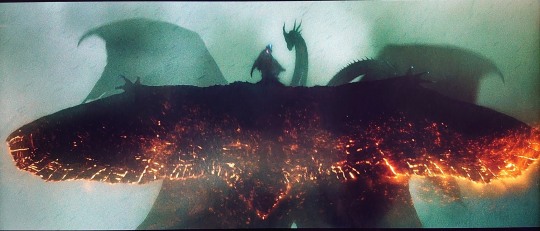
Homages A Plenty
There are so very many references in this film, both visually and via dialogue—“Easter eggs” abound! I’ll touch upon a very few, leaving exhaustingly listing them to other obsessive fans. I enjoyed the numbered MONARCH outposts having significance—the release year of the film in which the Toho daikaiju there contained was a delight and also the fun nod to THE THING in the Antarctica outpost numerical designation. Modernizing the Shobijin by having Doctors Chen and Ling, and generations of twins in their family, as “priestesses” of Mothra is an excellent touch. The new Titans are gleeful references to mythology and cryptozoology, demonstrating that many cultures have embraced daikaiju throughout history. Intriguing archaeological mysteries are touched upon such as 12,000 year old Göbekli Tepe, hinting at past humans dealings with Titans. Even an article in the jam-packed end titles is authored by Steve Martin, the character played by Raymond Burr in the American version of the 1954 film which was first to be titled GODZILLA, KING OF THE MONSTERS.
MONARCH’s mission critical submarine is named USS Scorpion, after an American nuclear submarine which was lost under mysterious circumstances, and it has a Captain Crane, like The Seaview in VOYAGE TO THE BOTTOM OF THE SEA. Its conning tower likewise has Seaview-esque planes and shape. The skeleton of Anguirus has a cameo, briefly glimpsed outside of Godzilla’s temple lair, and if only we’d gotten a better look at more of the Atlantean art paying homage to Godzilla—there seem to be monumental figures with Godzilla heads atop humanoid bodies holding some sort of ceremonial weapons which Serizawa passes on his way to revive his “old friend.” A sculpture of Pazuzu is glimpsed atop a step pyramid in that lost city—such artifacts all sadly obliterated to revive Godzilla. Some more time to drink in this elaborately detailed majestic setting would have been appreciated.
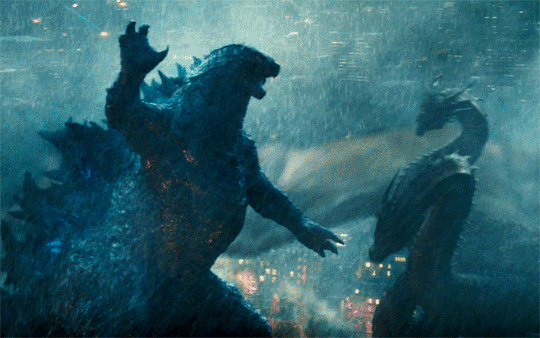
Several key plot events here are reshufflings from past Godzilla films. The concept of one daikaiju sacrificing itself to revive another was pivotal in GODZILLA VS. MECHAGODZILLA 2. There, Godzilla is tortured to near death by electrodes from Mechagodzilla which pierced his body and fried his secondary enlarged ganglial areas. Fire Rodan, nearly expired from his conflict with Mechagodzilla, as a dying act drapes himself atop the fallen Godzilla, evaporating into a sparkling mist and then both healing and resurrecting Godzilla, who now has an even more powerful, red-tinged plasma beam. In GMK, Godzilla is the “heel” who fights the more positive trio of Baragon, Mothra and King Ghidorah. Godzilla seemingly kills King Ghidorah, so Mothra makes a direct, suicidal flight at Godzilla who evaporates her with his plasma breath—shared imagery with Daugherty’s film, though here King Ghidorah and Godzilla have reversed roles. In Kaneko’s film, Mothra’s energy descends upon King Ghidorah in a sparkling cloud, reviving him and enhancing his wings and gravity beams for the final combat with Godzilla. That Godzilla thrives on exposure to radiation has long been part of the basic lore of many of the films, and his revival and enhancement through extreme exposure was no surprise as being primary to the MONSTERVERSE’s mythology. And the scene wherein King Ghidorah “powers-up” via biting electrical cables in the Boston battle reminds me of Kong being electrically revived in the original KING KONG VS. GODZILLA. Godzilla’s expression as King Ghidorah takes that bite, and then the massive arcs of electricity that spread out from his wings to clear the attacking human’s jets are both such memorable moments—which could have been given just a bit more time to accommodate earned “oohs and aahs.”
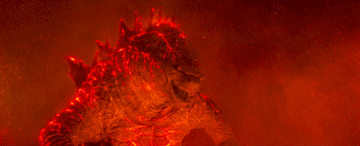
The novelization of GODZILLA: KING OF THE MONSTERS goes into detail about some of the Titans only glimpsed or simply listed in the film, and one hopes they’ll emerge in the next or further MONSTERVERSE installments—if any. There is a beautiful, brief passage in the book which is told from Godzilla’s point of view. We see through his eyes his responsibility as the lord and protector of this world—the globe is his domain and he is aware of the entire planet, sensing time passing through the shifts in Earth’s tectonic plates. He is aware of the much younger Kong, but unconcerned as Kong is only responsible for Skull Island. We know Kong is the last of his kind, and Godzilla also seems to be as well, though in the comic prequel to this film the story of the Godzilla-esque skeleton infested with the two Muto spores was explained as being Dagon—perhaps his elder “cousin”? The Muto which killed him was vanquished by Godzilla between the 2014 and 2019 films in that comic, which also serves to explain the change in his dorsal plates, which Dougherty has said are continually growing, like antlers. It would be a delight if the Kraken, snoozing as it embraces a sunken nuclear submarine, and Mokele-Mbembe, designed according to the legends as part serpent and elephant, had scenes in the films to come. If Godzilla at some point must sacrifice himself to save the world, discovering another younger member of his species in the Hollow Earth regions would not be surprising and would also embrace that “son of Godzilla” concept used in Toho’s series. The sunken Atlantis being part of the subterranean world evokes Verne’s JOURNEY TO THE CENTER OF THE EARTH, and of course the 1959 film adaptation concludes with a gigantic lizard menacing the remains of the Lindenbrook party in its ruins. Perhaps there are other humans (humanoids) “down below” as well, in fascinating antediluvian cities, much as Toho posited with the Seatopians, or even like the subterranean Sumerians from THE MOLE PEOPLE? Possibilities abound!
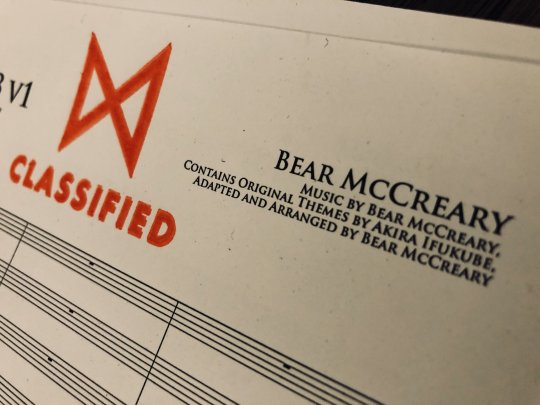
The Score
We’ve been quite fortunate that the scores for Hollywood Godzilla films have been powerful, thematic, and thoughtfully composed works wrought by talented composers. Both Arnold and Desplat crafted magnificent music that expressively carried the action. McCreary’s is the first MONSTERVERSE score to incorporate iconic themes for both Godzilla and Mothra from the Toho scores, and these quotations were well-timed and heightened the drama. Additionally, his new themes are both strong and memorable. The thematic material for King Ghidorah constantly iterates the number three, and the general rising melodic line is even kin to that of Holst’s “Mars, The Bringer of War” from THE PLANETS. The chanting monks’ voices offer a mysterious sense of religious awe to support the diabolical “destroyer of worlds.” Rodan’s theme features whooping horns, as if to echo the “Samurai of the Skies” cries. Even the film’s opening quiet theme has that “Go-Ji-Ra” rhythm that was used in both the 1998 and 2014 films to craft memorable new musical signatures for the King of the Monsters. Most touching was the gorgeous choral music accompanying Serizawa’s Spock-esque sacrifice—which even visually rhymed the descent of the mini-sub with the photon torpedo casket sequence from THE WRATH OF KHAN. The MONSTERVERSE’s Serizawa is essentially a transmogrified Dr. Yamane from the 1954 GOJIRA, a man who studies and appreciates Godzilla as a living being. By having him sacrifice himself not to destroy Earth’s dominant Titan, but to revive him with a nuclear weapon and thus save humanity, works as a pragmatic inverse linking him to the original Dr. Seizawa, the self-immolating physicist who conceived of far too deadly a weapon in the Oxygen Destroyer. McCreary’s “requiem” suited that sequence to perfection. When Godzilla rises again and blasts forth his plasma beam into the sky, the Ifukube-based accompaniment was deeply moving, and the moment Godzilla looked to his human saviors was delightful. He seems to acknowledge their role, much as that of the people from a past civilization who had idolized him, and the soundtrack even has a fleeting phrase of Ifukube’s Godzilla theme much as it was scored for high woodwinds in the requiem from GODZILLA VS. DESTOROYAH—a very brief and subtle nod. McCreary’s triumphant symphonic apotheosis of his own opening Go-ji-ra theme over that concluding acknowledgment of the Earth’s true monarch brought me chills. Being followed immediately by McCreary’s magnificently over-the-top arrangement of B.O.C.’s song “Godzilla” to commence the end titles was fan service of the highest order. Its refrain, “History shows again and again how nature points out the folly of man!” is of course the underlying theme of the Legendary MONSTERVERSE. “Bravo!” Maestro McCreary!
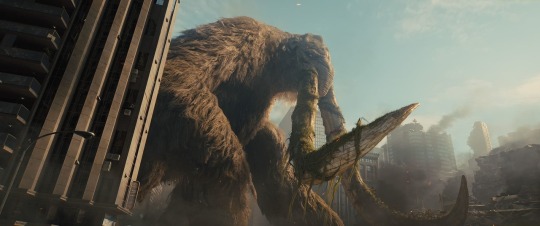
Could Be Bettered
Some minor cavils. I prefer to hear the word Ghidorah pronounced in the more euphonious Japanese manner, with the three syllables (ghi-do-rah) given equal emphasis and the first one slightly higher in pitch. One can hear it when watching Toho’s original Japanese prints with English subtitles. Americans emphasize the second syllable (Ghi-DOR-ah), and thus the middle one sounds like the English word door, while the Japanese put the R on the third syllable. I’d have dropped that weak gonorrhea joke, and the “very long fortune cookie” line was a tad clumsy, and a bit out of place for the dignified Serizawa. In this film he seems to take a bit of a back seat to Dr. Mark Russell, once he’s on the scene, which is a bit of a disservice to his character for me. And that his sidekick Dr. Graham is so quickly dispatched by King Ghidorah during his emergence seemed a bit too casual—her character was a fine one, and I’d have enjoyed more from her going forward.
The film brings back the Oxygen Destroyer, a wonderful nod to the original, and they hint at it being tested in the news crawl Madison and Emma have on in the background in their opening domestic scene at the China base. The news commentator’s reporting of “mass die-offs” must be from the military testing it. Rather than having it come as a surprise announcement when the incoming missile is announced by Admiral Stenz, I think that viewers should have been clued-in earlier, and rather easily. The audience primarily sees things from the point of view of the MONARCH characters. But if we go to that senate hearing scene, from which the MONARCH crew departs having been alerted to the eco-terrorist attack on their Mothra temple base—despite being warned that there will be consequences, that scene could have briefly continued. Admiral Stenz would reveal to the committee, once Serizawa and crew have departed, that the military now has a prototype weapon that they think could be used to exterminate the Titans. We’d cut from the blurred footage of the Mutos on the monitor to a graphic of the Oxygen Destroyer (what we saw later when Stenz alerts the Argo team), while Stenz declares this is their tested proposal for conquering the Titans. If one wanted to flesh it out, then perhaps running some brief footage of it killing fish or other forms of life with some dark accompanying music would be a strong punctuation. But even that wouldn’t be required, just that graphic and a Stenz voiceover would have done the trick. So, rather than ending on a weak joke about blurred Titan genitals, we’d have the Oxygen Destroyer’s revelation as added tension for its eventual use.
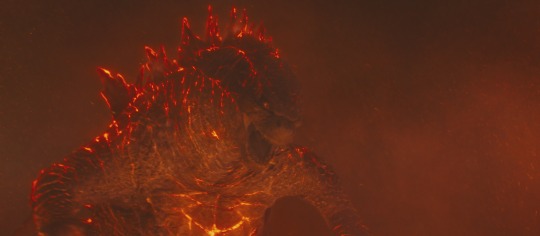
With such wonderfully detailed renditions of the Titans, particularly the four Toho guest stars, I think they went a bit too far in trying to fit them into their environments by surrounding them with clouds, mists, and fog. This gives the Titan scenes an overall soft and painterly feel, and I can enjoy that aesthetic choice, but seeing the creatures that were so very carefully designed, and whose movements are crafted in such a convincing manner, being obscured far too often I think was an error. Dialing that back somewhat would have been a wiser choice—show us what you’ve got! Particularly in the expert choreography of the battling Titans—which in some scenes appears to have been inspired by Matt Frank’s compositional style—being able to see how the tussles and tumbles progress with greater clarity would have enhanced the viewing experience.
Wishful Thinking
I would hope that there might eventually be a “director’s cut” in some future boxed-set home video release of the MONSTERVERSE films that would relax the pace of this film somewhat—taking time to linger on the beautifully crafted images so that we won’t have to freeze-frame to savor the glories on screen. And the storyboarded but unfilmed mid-credit scene of another Mothra egg being sung to by twin young girls in another hidden temple space beneath a modern city should be added-in or at least exist as part of the extras—possibly an animated version? If the box office returns from the next installment don’t justify further live action films, it would be fun to have a MONARCH-centered animated series exploring the numerous Titans and how humanity must deal with them. The cartoon series that followed the 1998 Emmerich GODZILLA film was quite an improvement over its progenitor, so I suspect something similar could happen with this franchise going forward once live action films are no longer produced.
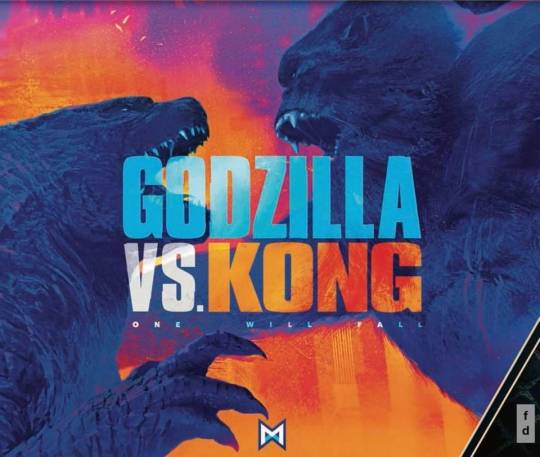
The Coming Conflict
Daugherty has reportedly had some plot input towards Wingard’s upcoming GODZILLA VS. KONG, and so the end titles give us glimpses into what might be to come via various briefly shown illustrated articles. One explains that the newly emerged Titans were being drawn to Skull Island, so one has to wonder if that locale could at the conclusion become the “Monster Island” of the MONSTERVERSE? That it is a gateway to the Hollow Earth is an exciting prospect, for more mysteries abound there. Already the rumor that the APEX corporation, which funded Colonel Alan Jonah’s eco-terrorists, is now behind the construction of Mechagodzilla (the toys of this character have been leaked already), who will have an ORCA variant built-in to lure Titans to the slaughter.
King Ghidorah can regenerate in an unearthly manner and the director has mentioned in interviews that his consciousness is spread through his body. Daugherty has said that whatever might have fed on the carcass head could perhaps become some sort of mutating “legion,” perpetuating King Ghidorah, from flies to any sea creatures that took a nibble, if the series goes on. The rumor mill suggests that materials from the brain of this dead head have been used to create a bio-tech controller to enhance Mechagodzilla. Now that we’ve gone to a Showa series sensibility, the film makers have a great deal of latitude for referencing some of the more fantastic concepts from earlier films. With the biggest blockbusters today being super hero fantasies, one need not try to pretend that MONSTERVERSE films are bounded by the laws of our Universe. The relatively more “realist” approach of Edwards’ 2014 GODZILLA has been evolved into a broadly fantastic approach, which reflects much of what Toho had done in all of its series.
Fan Reactions
It seems some Godzilla fans on message boards are now turning on Dougherty’s epic—everyone seems to want each new film to be their vision of the perfect Godzilla film and then disappointment sets in when it isn’t. Yet so many of the films throughout the ongoing saga of Godzilla have been silly, cheesy, daffy, and sometimes just dopey—yet many of we aficionados embrace them all for their charms, after all, we get to see more of Godzilla and his fellow daikaiju. They appeal to quite a wide range of viewers of all ages, and as one ages, different films might head a favorites list based on one’s evolving tastes. Better that more Godzilla tales are wrought and released, regardless of whatever flaws we might find. In GODZILLA: KING OF THE MONSTERS the incarnations of our old favorites and some intriguing new Titans are truly extraordinary, brought to vivid life with contemporary effects capabilities. Never before have these sorts of films been graced with such mammoth budgets and been seen by such large audiences around the globe—a golden age for Godzilla is upon us.
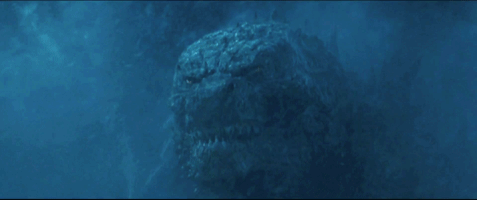
Huzzah Daugherty!
Despite its flaws, I find so much to love in this film, particularly that final scene. After Godzilla has vaporized his age-old rival and literally “smoked” his final head, the Titans summoned by Madison’s activation of the ORCA in Fenway Park arrive. Godzilla, battered and weary from his strivings has exhausted the energy gifted to him through his ally Mothra’s sacrifice—like Heracles after his many labors. This unbowed victor is at last confronted by the other awakened super-species. It looks like a further battle could ensue, as Rodan swoops down at last. But, that canny firebird knows his place and thus submits to the true king, with a nod and almost a courtsey-like gesture of his cape-like wings. The other Titans then “bend the knee” and Godzilla bellows his triumphant “skreeonk” as McCreary’s music superbly supports this coronation scene. I felt such a powerful frisson at that moment and do with each repeat viewing. The Titans demonstrate their consciousness, intelligence, and their sense of natural hierarchy in what is one of my favorite conclusions in the entire canon of Godzilla films.
So, I salute Daugherty and all the others involved in what for me is a grand outing for all of the Titans and a very fine addition to the roster of Godzilla’s adventures. I’ve watched it many times since I saw that first Thursday night preview screening, and I continue to enjoy it immensely. Like all of the earlier films, I don’t dwell on what I see as flaws, but I celebrate the unique wonders that have been wrought, and these abound in this Toho-redolent GODZILLA: KING OF THE MONSTERS.
The bar has been raised. Batter-up, Adam Wingard—let the MONSTERVERSE continue!
—Peter H. Gilmore
19 notes
·
View notes
Text

Yuki vs. Fleshworld, where to begin? The Daikaiju Yuki franchise has always been an interesting beast. (Ha…puns) From what could be a typical post apocalyptic setting we were treated to a mythological conglomeration which blended fantasy, science fiction, and the particulars of Kaiju-eiga into a rip-roaring adventure. That’s the key thing here, the Pantheon Colossi books are almost always about ramping up the stakes and fun. It never grows tiring, it all makes sense, and the binding ties here are always the characters interactions with eachother and Yuki Tsubaki’s growth as a person.
Fleshworld rivals the original book in my favor. Both are explicitly about bursting open a new world and exploring it completely. Y2K is as strong as anything but it feels as though it was more a chrysalis from which something COSMIC and MASSIVE could be born. One of the things I love about each of these subsequent entries is that Coronelli takes pieces scattered amongst the larger narrative and dissects them and lays bare all of their intricacies for the reader to explore and enjoy.
The most compelling element here in Yuki’s introspection and her being given a doppelganger of sorts in Admiral Yamanra. THE most successful human villain in all of these books. Yamanra exists as a dark future for Yuki. She matches her in boldness both sexually and in terms of strategy. She commands legions and is as fierce a warrior as Yuki. Yet she lacks, and it’s through these encounters that Yuki understands what she must never become and what it is that makes herself the character we want to read.
Flesh World is a key element in a way that isn’t quite what you’d expect going in for monster action. The whole concept of Kaiju and Dreadnoughts has been a question of equilibrium and balance with planets and their source of mana energy. What happens when the planet is a monster in and of itself? How do you relate to that idea? How do you fight it? Is there something more to be said?
The sheer variety of creatures is also an added bonus simply because the mashups of concepts and animals are all so eclectic and reach near Yokai-levels of peculiarity (Looking at you Mantis-Walrus and Kick Ball alien.) If this is the end, then it feels that Yuki has undergone an entire arc and become as mythic a hero as the Pantheon was before all of this started. Yet there are clear hints at greater adventures still and with a universe like this, it’s impossible to know what weirdness stirs in the dark. We do know that when Coronelli unveils it, it’ll be surprising in the best way!
12 notes
·
View notes
Photo

A god incarnate. A city doomed. Shin Godzilla piece full reveal from the @guzugallery Shin Beasts art show last weekend. "Roar" a 5 color, 18" x 24" screen print poster available at Guzu Gallery store and online shop starting this week. ------ #godzilla #shingodzilla #kaiju #gojira #screenprint #posterart #movieposter #funimation #daikaiju #artwork #art #godzillaart #monsterart #like #love #follow #guzugallery #artshow #screenprinting #poster #posterdesign #atomicbreath #godzillaresurgence #hideakianno #evangelion #giantmonster #strangebeasts (at Guzu Gallery)
#art#atomicbreath#godzillaresurgence#screenprinting#posterart#artwork#godzillaart#strangebeasts#daikaiju#follow#evangelion#love#movieposter#artshow#shingodzilla#giantmonster#poster#posterdesign#funimation#monsterart#hideakianno#guzugallery#gojira#kaiju#godzilla#screenprint#like
7 notes
·
View notes
Text

Did I ever post this here? A good while ago I took screenshots of each Gangle expression from this video showing off some of the versatile expressions Gangle can have!
#Which one’s your favorite?#I like the fifth one on the third row#Digital Circus#the amazing digital circus#tadc#Gangle#Daikaiju roars
2K notes
·
View notes
Text
RaeGojirin vocalizations
17 notes
·
View notes
Text
10 songs 10 mutuals
Tagged by @elfmaiddryope! Thank you for tagging me!
Rules - put your music on shuffle and write down the first ten songs that play:
1. Amnesia - Mind in a Box
2. Farewell to Monster Island - DaiKaiJu
3. Let It Die - Three Days Grace
4. Archangel - Two Steps from Hell
5. Summer (Where do we begin?) - Phineas and Ferb
6. J-E-N-O-V-A - The Black Mages
7. Headlock - Imogen Heap
8. The Patient - Tool
9. A Messenger From Behind - Kō Ōtani (Roar of the Earth album)
10. Planets - Adema
I will tag.... @marie-dreamland164, @scartale-an-undertale-au, @getful, @driku12, @blackpapersnowflakes, @drwhowantslasagna, @thewhaleridingvulcan, @4jen, @littlebatwitch, @izzymadwoman Remember! Being tagged is not being obligated if you aren’t feeling up to it! :D
7 notes
·
View notes
Photo

WHEN ELLA LENTINI LIKES ALL OF YOUR HANNAH FANART

98 notes
·
View notes
Text
The History of Reptilicus
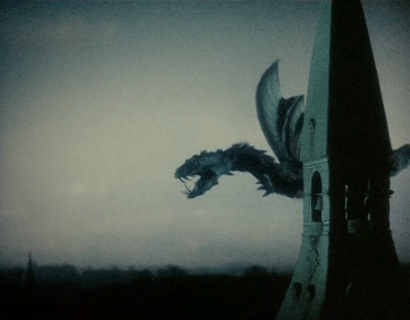
When Mystery Science Theater 3000 debuted on national television in 1989, the first victim of Joel and the ‘Bots was The Crawling Eye, a British monster movie. The show’s revival on Netflix begins with another creature feature filmed in Europe, Reptilicus. I had the pleasure of watching this episode at the Season 11 premiere in New York and thought it was incredible, with a blizzard of quality jokes and a monster rap for the ages. Certainly Reptilicus was an excellent target: the monster is laughable and the comedy is horrifying. But there’s an incredible story behind the making of that 1961 movie, and a trio of strange adaptations that followed it. MST3k, by its nature, can’t tell that story, so I’d like to give it a try myself.
Sidney Pink produced almost 25 movies over the course of his career. To his dismay, Reptilicus became the most famous of them. At the time, he went all in on the dragon from Denmark: aside from producer duties, he directed it and came up with the story. Though the novel concept of a giant monster movie set in Copenhagen was the idea of AIP co-founder Jim Nicholson, Pink’s pre-existing relationship with Saga Studios made it possible. That connection also led to Reptilicus’s occasional moments of high production value. Fleming John Olsen, who owned Saga, used his influence as a member of the majority-ruling Social Democratic Party to secure the cooperation of the Danish army and navy. Unlike many of its contemporaries, all the footage of the military in Reptilicus was shot for the movie, even the Albatros-class corvette firing depth charges.
Reptilicus was the first science-fiction movie made in Denmark in almost fifty years. The hype generated for it by the press gave Pink tremendous freedom in filming scenes of panic in Copenhagen. One thousand extras participated in the drawbridge scene, with members of a bicycle club agreeing to plunge into Copenhagen Harbor.

The premiere, of course, was a disaster. Mystery Science Theater was this movie’s destiny from the beginning, as audience laughter gave way to outright heckling. The formal reviews were no kinder. In Jack Stevenson’s book Land of a Thousand Balconies, he states that, “To this day, Reptilicus is responsible for some of the most colorful and excited prose in the entire history of Danish film criticism.”
Though Reptilicus features lines like "You'll have to fire point-blank, at very close range," its special effects provide the richest target for mockery. One look at the film's miniatures make the problem obvious: they were built at too small a scale to be convincing. Set photos from the film are rare, but the few available show monster props about seven and four feet long. Shots using the former turned out decent enough, but the latter never looks like anything but a floppy marionette.
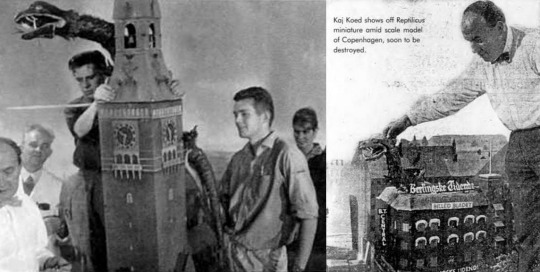
The version of Reptilicus that became a national embarrassment to Denmark was quite different from the product unleashed on American theaters and the Satellite of Love – and in my opinion, a little bit better. The dialogue scenes in Reptilicus were filmed simultaneously in English and Danish, with Poul Bang directing the latter. Every character in Reptilicus was played by the same actor in both versions, with the exception of Connie Miller (Marlies Behrens in the American version, Bodil Miller in the Danish version). You can see the problem with that approach: the largely Danish cast delivered their English lines with heavy Danish accents. AIP’s other founder, Samuel Z. Arkoff, was mortified at their performances, and demanded that American voice actors re-record all the dialogue. Pink, who was used to the accent by then, sued AIP when it refused to distribute the movie. After his lawyer looked at the Danish performances for himself, he convinced Pink to drop the case. Reptilicus was dubbed by Titra, a New York company which handled countless Japanese monster movies throughout the Sixties and early Seventies, and released in the United States in 1963, almost two years after its Copenhagen premiere. Ib Melchior, the screenwriter, claims to have dubbed six different characters himself. The original English audio is unlikely to ever surface.

Danish version on the left, American version on the right.
The Danish Reptilicus, shot from the same script as its American counterpart, has basically the same plot, with two major exceptions. Dirch Passer, a legendary comedian in Denmark, received his own musical number about the monster, which he performs with a mysterious gaggle of children who are never seen again. Reptilicus also flies in the Danish version. For some reason, AIP felt that those shots were unacceptable, though its own version added some special effects which were even worse. The neon green slime Reptilicus spits from his mouth is the most famous, but the American version also shows him devouring a farmer in a shot so hysterical that the roar of the audience at the MST3k premiere made Crow's joke impossible to hear.
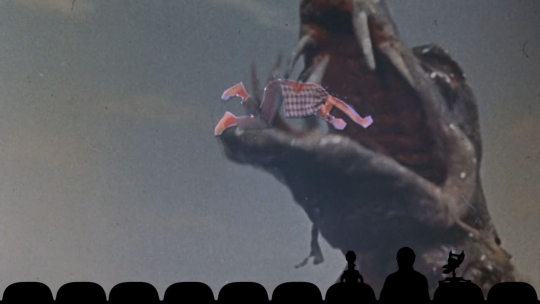
Reptilicus received a novelization from Monarch Books and a comic book from Charlton Comics. The novelization was written under a pseudonym by Dudley Dean McGaughy, who primarily worked in the western and crime genres. He... took some liberties with the source material. As Bill Warren explains in Keep Watching the Skies, "Along with Monarch novelizations of Konga, Stranglers in Bombay, Brides of Dracula, and Gorgo, it was the closest thing to over-the-counter pornography as you could find in the early 1960's." Sid Pink, who received credit for the original story, sued AIP and Monarch again for using his name in the book without permission.
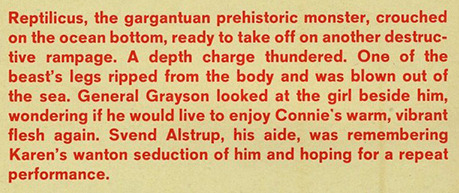
Charlton's take on Reptilicus was more conventional. The first issue was simply an adaptation of the movie, while the second took a freshly-regenerated Reptilicus on an adventure in Africa. Then the character mutated.
Pink never sued Charlton – in fact, he never knew about the Reptilicus comic until years later. However, comic book veteran Stephen R. Bissette postulates that his action against Monarch caused Charlton to change the characters' name preemptively. In his third issue, Reptilicus became Reptisaurus the Terrible. Reptisaurus wasn't all that different from Reptilicus, just red, less toothy, and with a new prehistoric origin completely divorced from the movie. He became a monstrous anti-hero patterned after Gorgo and Ogra, who had their own Charlton comic. Like them, he fought Communists, repelled alien invaders, and ate atom bombs for breakfast. In a crossover less exciting than it sounds, he actually appeared in an issue of Gorgo, swooping in to smash some flying saucers. For some unfathomable reason, however, the story concluded without a face-to-face meeting between Europe's premiere giant monsters. In his seventh issue, Reptisaurus received another makeover, growing a nasal horn and more powerful limbs. This version was much better-drawn, but only lasted another two issues.
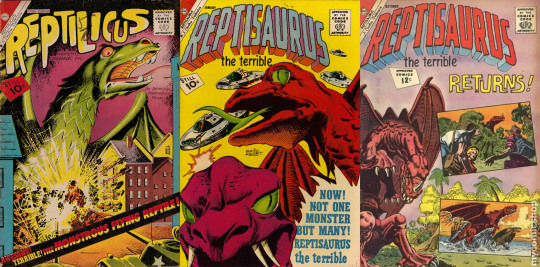
Scary Monsters magazine published all the Reptisaurus the Terrible issues in a book called Scarysaurus the Scary in 2012, with every mention of the monster's name clumsily replaced. Why the change? Well, they might have been trying to avoid any legal entanglements with the makers of the movie that had come out in 2009. Reptisaurus was the first movie directed by Christopher Ray, who has gone on to have a prolific career with The Asylum. As far as I can tell, it's only available on DVD in Japan and Thailand, making it exceptionally hard to find. But if the trailer’s any indication, you're not missing much. The monster himself is a Wyvern 2.0 model currently sold by DAZ 3D for $14.95.
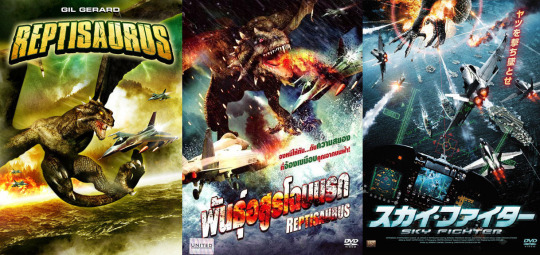
Since Reptilicus was released in the days when the only people who cared about box office returns worked in the film industry, I can only say that it turned a profit for AIP. Its reputation as a bad movie of legendary proportions would develop over time. Mystery Science Theater 3000 is sure to raise its profile, but the American version has been readily available on home video for a while now, with each new format helping a new generation discover its unique charms. The Danish cut came out on DVD in 2002, though you'll need to do a bit of Googling to find an English translation. And if you find yourself curious about what such a film's screenplay was like, Reptilicus superfan Kip Doto published it in 1999, along with a detailed commentary, after befriending Sid Pink. Doto also helped facilitate the production of a Reptilicus toy by M1 and Club Daikaiju the following year.
Before he passed away in 2002, Pink unsuccessfully attempted to find financers for either a remake or a sequel to the movie. An attempt by a small Danish company to create a video game in 2015 also seems to have fallen through. Still, history shows again and again that no giant monster can be counted out entirely. If Moguera, Yongary, and Guilala can roar back decades after their original appearances, the not-too-distant future could very well see a wobbly lizard darken the skies over Copenhagen once more.
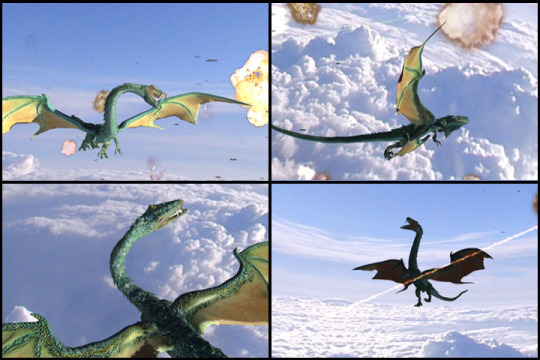
Sources and Additional Reading:
“It Came from Beyond Belief - The Incredible Movies of Sidney Pink in Denmark” by Jack Stevenson (republished in Land of a Thousand Balconies)
“You Say Reptilicus, I Say Reptisaurus — The Charlton Monster Comic Saga, Concluded!“ by Stephen R. Bissette
Keep Watching the Skies!: American Science Fiction Movies of the Fifties by Bill Warren
Flying Through Hollywood by the Seat of My Pants by Samuel Z. Arkoff with Richard Trubo
Both issues of Reptilicus on Comic Book Plus
Every issue of Reptisaurus the Terrible on Comic Book Plus
Glenn Erickson’s review of the 2001 MGM Reptilicus DVD
Mention of the Reptilicus remake on the site of CG animator Gary Dohanish
Undead Backbrain AMA with Reptisaurus director Christopher Ray
255 notes
·
View notes
Video
If only it actually had a Gamera roar... featuring Trendmasters 90s Godzilla . . #trendmasters #trendmastersgodzilla #trendmastersgamera #toys #trendmasterstoys #godzilla #gamera #kaiju #daikaiju #godzillatoys #gameratoys #kadokawa #daiei #turtle #turtles #otaku #weeb #weeaboo #gameraguardianoftheuniverse #heiseiera #heiseigamera #nostalgic #nostalgia #toycollection https://www.instagram.com/p/B0O30H2AL0Q/?igshid=1uciojs81m1i9
#trendmasters#trendmastersgodzilla#trendmastersgamera#toys#trendmasterstoys#godzilla#gamera#kaiju#daikaiju#godzillatoys#gameratoys#kadokawa#daiei#turtle#turtles#otaku#weeb#weeaboo#gameraguardianoftheuniverse#heiseiera#heiseigamera#nostalgic#nostalgia#toycollection
0 notes
Video
instagram
So I am big on #aromatherapy I suffer from #migraine #headaches so a few months ago my #humidifier I use for my #essentialoils died and I have been getting nose bleeds because of how dry my nose is and more headaches as well as not sleeping all that well I have been really missing humidifier I have had this one saved for over a year but I couldn’t afford the $70 price tag then today I found one on clearance for $10 with FREEEEEEEEE shipping it’s by @whatonearthcatalog I didn’t get it through the I got it on amazon there are more but they are $25 I don’t know how I got so lucky. Now maybe my nose will stop bleeding now. I am so excited the I am going to do #themoreyouknow post today Godzilla!!!!!!! godzillaodzillais a multicultural icon. If there was a Coca-Cola commercial featuring monsters that sung the national anthem, he’d be singing his part in a mixture of English and Japanese. He’s been terrorizing Tokyo for longer than Disneyland has been around. Over the span of 60 years, he’s battled Earthlings, space monsters and robots, spawned offspring and chased Matthew Broderick, all while belting out the most iconic roar in film history. He’s appeared in 28 Japanese films, a 1998 American film and an upcoming 2014 reboot, countless comic books, novels, video games and TV. That’s an astounding feat of sustainability. The daikaiju has nestled in our hearts (and nightmares) carving out a permanent place in the annals of entertainment lore. But even more astounding is Godzilla’s secret past. Where did Godzilla come from, and why? In anticipation of Godzilla 2014 hitting theaters May 16 (directed by Gareth Edwards, and starring Bryan Cranston, Elizabeth Olsen and Ken Watanabe), here’s a brief guide to the monster’s origin story. The truth may actually blow your mind. Godzilla is the original radioactive superhero — or antihero, in this case. The reptilian giant was born out of a genre of Japanese film called Hibakusha Cinema, developed in the unique cultural climate of post-war Japan. At the time, there were several prominent factors at the forefront of popular thought, a brief examination of which makes it easy to see what exactly led to the monster’s (at Queen Creek, Arizona) https://www.instagram.com/p/BxCKjuFBeHR/?utm_source=ig_tumblr_share&igshid=gh356liocz3k
0 notes